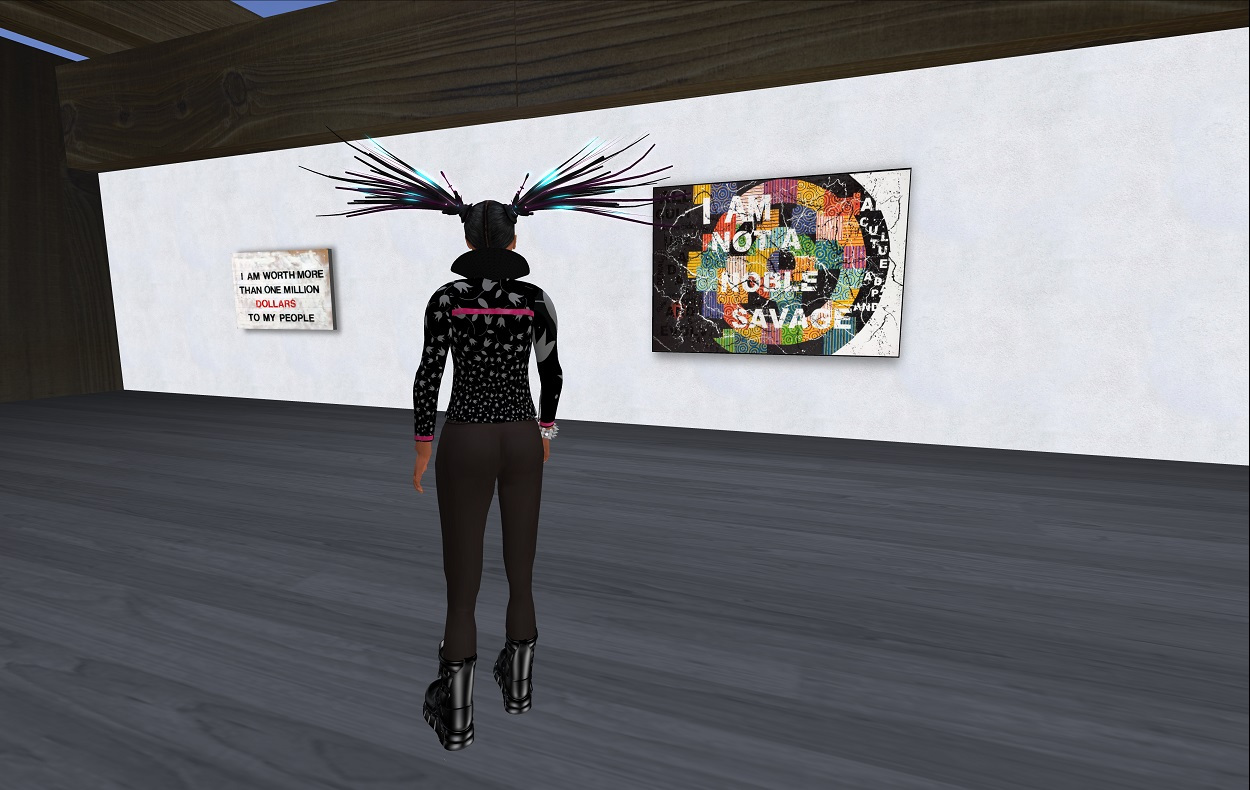” I want there to be an Indigenization of Cyberspace” (Skawennati, 2018).
I was looking for online space which offered Indigenous peoples an arena to connect over art, history, stories, etc. and I came across Aboriginal Territories in Cyberspace. Mohawk artist, Skawennati created a virtual island where users can navigate different online space like art galleries, moments from the past like the Oka Crisis, and even imagined futures. With the software, Second Space, Avatars are able to move through these spaces and communicate with other users. Once a week, graduate students like Maize Longboat will great these guest which can log in and wander at their leisure (CBC Radio). AbTeC Island “is an online community space, where Second Life users can hang out and talk. But it’s also a place where the ancient and the futuristic coexist” (McNamara, 2020).

Art in America. (2020, July 1). Photos: Skawennati’s Online Indigenous Communities. Retrieved from https://www.artnews.com/gallery/art-in-america/aia-photos/photos-skawennatis-online-indigenous-communities-1202693118/
AbTeC describe the island as an “autonomous zone, a space of Indigenous self-determination” (McNamara, 2020). It is designed and moderated by Indigenous creators who are sharing their own stories.
In addition to the AbTeC island, there are workshops designed to teach Indigenous youth to become creators in a virtual space. By teaching gaming skills, and design, the workshops aim to have stories be told in a new way, and in a space that can be shared. Skawennati wants AbTeC to be a place where stories are shared. She claims “It doesn’t just have to be our traditional or ancient stories. It can also be stories about who we are today. It can also be stories about who we want to be in the future. But what’s important is that it’s our stories. And we realized that we need to teach people how to use the tools in cyberspace” (CBC Radio).
Having a virtual place connects to what Howe (1998) discusses in his spatial pillar for tribalism. Here he notes that the cyber world is nameless and not geographical. In many ways he is correct, but artists such as Skawennati are taking back the online spaces that have been typically designed and sold by a Western lens. This lens is telling a story about peoples who have historically been left out of the ‘picture’. So in a sense, she is claiming a new geography in a new futuristic world. Images from AbTeC Island would prove to be a great visual digital literacy lesson for SS9.
References and links
McNamara, R., (2020, July 1). Skawennati Makes Space for Indigenous Representation and Sovereignty in the Virtual World of Second Life. https://www.artnews.com/art-in-america/features/skawennati-abtec-island-indigenous-community-second-life-1202693110/
CBC Radio. (2018, May 10). Indigenous virtual reality: An experiment in ‘Indigenization of cyberspace’ | CBC Radio. CbC. https://www.cbc.ca/radio/unreserved/from-soapstone-carving-to-second-life-indigenous-peoples-in-quebec-embrace-tradition-and-technology-1.4645198/indigenous-virtual-reality-an-experiment-in-indigenization-of-cyberspace-1.4654306
This is awesome, Mandy and I love the connection you made with Howe’s (1998) article and the ideas about taking back spaces and how stories can be told and shared within cyberspace.
Hi Mandy,
Thanks for finding and posting about AbTeC island. This combines a couple of things that I’m focusing on in my final project: online sovereignty and obsolescence.
Something that Skawennati mentions near the end of the McNamara (2020) article is: “How do you represent yourself as a Native person in these spaces? Why do we do that? Do we need to do that? I think they’re very important questions.” I find this very beguiling. I can see how difficult it would be to represent yourself in a space like this, let alone IRL if you don’t have a good idea of where you come from. So Skawennati’s questions of why represent as a Native person really comes down to how much do you know about yourself in that way, and feel comfortable portraying yourself that way. By no means am I saying “that” as being Native; instead I’m using “that” in a comprehensive way of how anyone would want to represent themselves. I feel it is important to understand who you are, and where you come from to be able to comfortably portray yourself in the way that you want. But if history has stripped this knowledge from you, or from reaching you this is going to be woefully impossible to paint your own picture. Therefore, spaces like these depicted in AbTeC are a useful place to find and connect to histories, and be able to connect to self through these histories.
Again, thanks for the post Mandy.
Neal